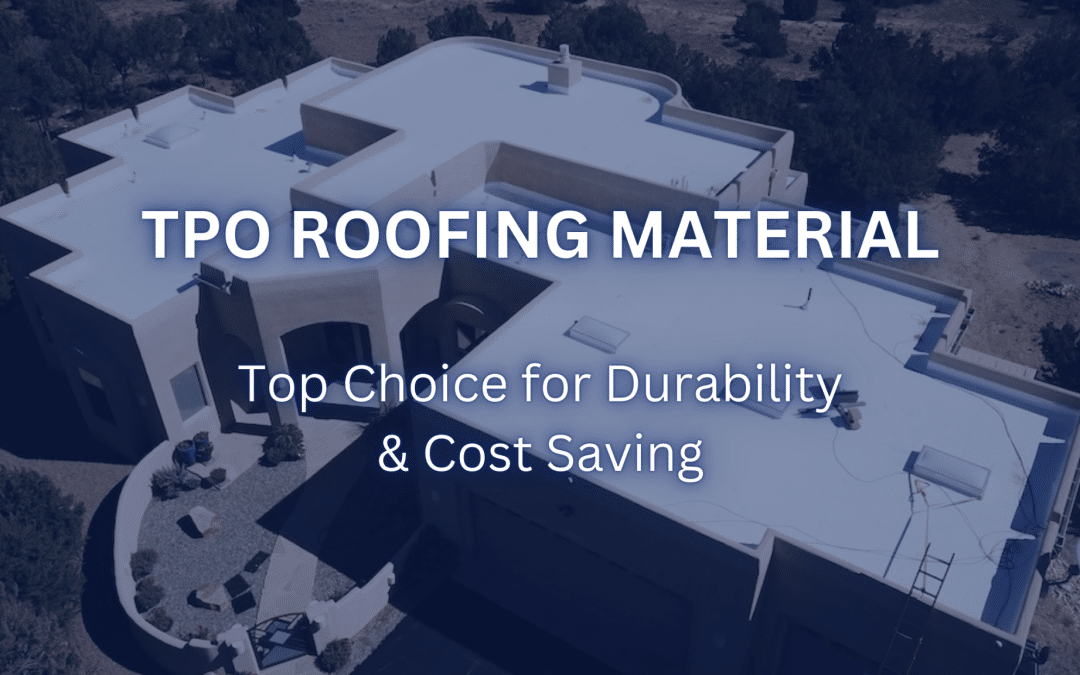TPO Roofing Material: What It Is and Why It’s a Top Choice
Rising energy costs and extreme New Mexico weather make homeowners and building owners look for a roofing material that delivers long-term durability and helps save money. TPO roofing material is one of today’s most popular single-ply roofing membrane solutions and for good reason.
This guide covers what TPO is, its key benefits, common roofing applications, and why it’s become such a top choice for property owners. According to the National Roofing Contractors Association (NRCA), TPO is the fastest growing segment in the commercial roofing industry.
What Is TPO Roofing Material?
TPO stands for thermoplastic polyolefin. It’s a blend of polypropylene and ethylene propylene rubber that creates a strong, flexible thermoplastic membrane. This single-ply roofing option works best on flat roofs and low-slope designs.
TPO roofing membranes are manufactured in large sheet widths and installed over the roof deck or existing substrate. Roofers use a hot air gun to heat-weld the seams together, creating strong seams and a watertight seal across the entire roofing system.
Depending on the installation process, TPO can be fully adhered, mechanically fastened systems (using mechanical fasteners or specially coated plates), or even mechanically attached with adhesives and a cover board for added protection.
This flexibility in TPO installation means it can adapt to a variety of roofing applications. A professional roofing contractor can recommend the right approach based on your roofing project, insulation needs, and existing roof conditions.
Benefits of TPO Roofing Material
Energy Efficiency
TPO’s highly reflective properties make it one of the best roofing membranes for hot climates. Its light surface reflects sunlight and UV rays, keeping interiors cooler during the hottest summer months. These reflective properties improve energy efficiency, cutting down on cooling costs. Many property owners see noticeable energy savings, often lowering their bills by 10–20%.
Because of its highly reflective surface, TPO also qualifies as an Energy Star product. Paired with the right insulation options, it becomes one of the most cost-effective ways to improve comfort and efficiency in homes and commercial facilities.
Cost-Effectiveness
TPO roofing costs are lower than PVC while still delivering similar performance. The competitive price per square foot makes it an attractive option for both homeowners and contractors. When you factor in reduced labor costs, easier TPO roofing installation, and long-term energy savings, the overall value is clear.
The advantages go beyond the upfront savings. With proper installation and regular maintenance, like removing debris and small repairs, most TPO roofs last 20–30 years. That’s a strong return on investment for any roofing project.
Durability and Weather Resistance
TPO is known for its durability in extreme climates. It resists UV rays, ozone, and chemicals, making it a reliable option in New Mexico’s intense conditions. Unlike EPDM, which can absorb heat, TPO has highly reflective properties that help extend its life.
The reinforcing scrim inside many TPO roofing systems adds strength, while the thermoplastic membrane flexes with hot air and temperatures without cracking. Hail, high winds, and severe weather are less of a threat when the system is properly installed.
Low Maintenance
Compared to other roofing materials, TPO requires minimal upkeep. There’s no need for special coatings or frequent treatments. Instead, regular maintenance like cleaning drains and removing debris is usually enough.
If issues do arise, TPO roofing membranes are easy to repair. Small punctures can be fixed with hot air patches that bond seamlessly to the membrane. This simple process lowers long-term costs and keeps the roofing system in good shape.
Typical Use Cases for TPO Roofing in New Mexico
TPO works well for both residential and commercial roofing. Homeowners with flat roofs or low-slope designs benefit from its energy efficiency and cost-effective performance.
In the commercial roofing industry, warehouses, offices, and retail spaces often use TPO roofing systems. Large roofing applications become more affordable thanks to the material’s wide sheet widths, fast installation, and lower labor costs.
For any commercial facility, the balance of energy savings, durability, and a competitive price makes it a leading choice.
Both new builds and roof replacement projects can use TPO. Whether applied over an existing roof or onto a fresh roof deck, it adapts easily with adhesives, mechanical fasteners, or fully adhered systems.
Why TPO Is a Top Choice for Homeowners
TPO combines energy efficiency, cost effectiveness, and long term durability better than many alternatives. Compared to EPDM, it offers better reflection of UV rays. While PVC has similar qualities, TPO’s competitive price makes it the smarter buy for most building owners.
The material also adapts to various systems, including mechanically fastened, fully adhered, or hybrid approaches, depending on the installation process. Its advantages make it one of the most reliable choices for modern roofing projects.
With millions of square feet of TPO roofing already installed across the U.S., the proven track record shows why it’s trusted in both residential and commercial roofing systems.
Considering TPO for Your Roof?
TPO roofing material represents one of the most practical roofing materials available. Its balance of durability, energy efficiency, and a competitive price makes it a smart choice for property owners planning a roofing project.
For best results, always work with experienced contractors who understand the full installation process and can recommend the right insulation options. With proper installation and regular maintenance, you’ll enjoy decades of energy savings and peace of mind.
If you’re ready to explore TPO for your home or commercial facility, contact East Mountain Roofing through our contact page for expert guidance on your next roofing project.



